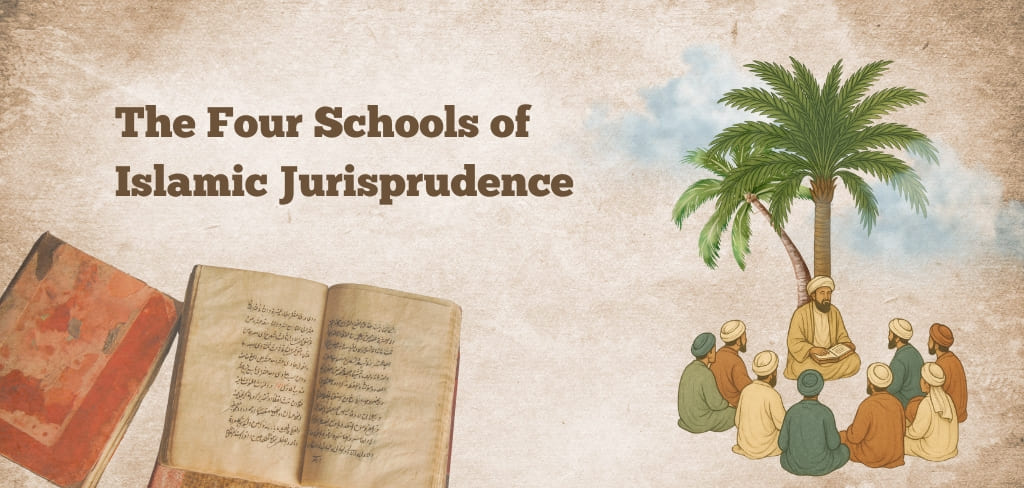Mu’awiyah (May Allah be pleased with him) reported:
The Messenger of Allah said, “When Allah wishes good for someone, He bestows upon him the understanding of Deen.” Fiqh (Islamic jurisprudence) in religion is the acquisition of knowledge, its understanding, and acting upon it with guidance and insight. The purpose of Islamic Fiqh is to provide answers to the questions arising from the realities of people’s lives—whether related to their livelihood, worship, or interactions—whether these questions are explicitly asked or not. This scope covers both individual realities and collective ones. Also, Fiqh is the knowledge of the practical Sharia rulings derived from their detailed evidences. Since this knowledge is extracted from the sources of Islamic legislation—primarily the Qur’an and the Sunnah—it is called Islamic Fiqh, meaning that Islamic legislation is its origin and foundation. Islamic Fiqh went through several distinct historical stages that shaped its features and contributed to its development and spread among Muslims. One of the most significant of these stages was the emergence of the schools of jurisprudence, which began in the early second century AH. During this period, the great Imams and jurists laid down the principles of Ijtihad and documented the rules of Fiqh. Each of them adopted a unique methodology in deriving rulings, which later became the foundation of the major schools of Islamic jurisprudence that spread widely among Muslims.
These schools are:
The Hanafi school, founded by Imam Abu Hanifa al-Nu‘man (may Allah have mercy on him), born in 80 AH and passed away in 150 AH.
The Maliki school, founded by Imam Malik ibn Anas (may Allah have mercy on him), born in 93 AH and passed away in 179 AH.
The Shafi school, founded by Imam Muhammad ibn Idris al-Shafi (may Allah have mercy on him), born in 150 AH and passed away in 204 AH.
The Hanbali school, founded by Imam Ahmad ibn Hanbal (may Allah have mercy on him), born in 164 AH and passed away in 241 AH.
In their process of establishing legal foundations, these schools agreed upon the four primary sources: the Qur’an, the Sunnah, consensus (Ijmā‘), and analogy (Qiyās), and this agreement was established unanimously. However, they differed in the partial evaluation of each of these evidences—both in their wording and implications—as well as in many other issues related to linguistic indications and methodologies addressed by the science of Usul al-Fiqh. This means that their differences arose within these shared sources, concerning the understanding and the methods of derivation.
The Hanafi school
Attributed to Imam Abu Hanifa al-Nu‘man (80–150 AH), the Hanafi school in fact encompasses the methodologies of the great scholars of the school—such as Abu Hanifa himself, Abu Yusuf, and Muhammad ibn al-Hasan—and was not restricted solely to Abu Hanifa’s own approach. The Hanafi school originated in Kufa, grew in Baghdad, and expanded further with the support of the Abbasid state. In addition to the agreed-upon textual sources, the school relied on analogy (qiyās), juristic preference (istihsān), custom (‘urf), the opinions of the Companions, and the laws of previous revelations. Thus, it broadened its use of rational principles and adopted stricter conditions regarding the acceptance of hadith, due to the complexity of life and the development of urban civilization in the Iraqi environment.
The Maliki school
This school is based on the juristic rulings derived by Imam Mālik (93–179 AH), who formulated them while adhering to both well-known general principles and specific ones. In addition to the foundational sources agreed upon by all Imams—the Qur’an, the Sunnah, analogy (Qiyās), and the consensus of the Companions—the Maliki school also relies on the practice of the people of Madinah and on considerations of public interest. Among the most prominent works of this school are Al-Muwaṭṭa’ by Imam Mālik and Al-Mudawwanah al-Kubrā, which contains Imam Mālik’s legal opinions compiled and recorded by Sahnūn ibn Saʿīd al-Tanūkhī. The Maliki school spread most widely in North Africa, Egypt, and al-Andalus, and many scholars also worked to disseminate it in Iraq and the lands of Khurasan.
The Shafi school
Its founder is Muhammad ibn Idrīs al-Shāfi (150–204 AH). He lived in Makkah, then traveled to Iraq, where he studied the Hanafi school in Baghdad before later settling in Egypt. His school came as a middle ground between the Hanafi school—which gave broader scope to opinion (ra’y)—and the Maliki school, which relied heavily on hadith. The Shafi school bases its methods of derivation and reasoning on the principles established by Imam al-Shafi, which he documented in his famous book Al-Risālah. He is considered the first to author a comprehensive work on the science of Usul al-Fiqh (principles of Islamic jurisprudence). Among the most notable Shafi scholars during his lifetime were his students: al-Rabīʿ ibn Sulaymān al-Jīzī, al-Rabīʿ ibn Sulaymān al-Murādī, and al-Buṭī. Some of the most renowned books of the Shafi school—besides Imam al-Shafi’s own works—include Fatḥ al-ʿAzīz fī Sharḥ al-Wajīz by al-Rāfiʿī, Rawḍat al-Ṭālibīn and al-Majmūʿ by al-Nawawī, al-Muhadhdhab and al-Tanbīh by al-Shīrāzī, and Tuḥfat al-Muḥtāj by Ibn Ḥajar al-Haythamī.
The Hanbali school
Its founder is Imam Aḥmad ibn Ḥanbal (164–241 AH), and it is the last of the four schools chronologically. Ibn Ḥanbal believed that Fiqh should be based directly on textual evidence from the Qur’an or Hadith, and he criticized his teacher al-Shāfi for relying on opinion (ra’y), considering hadith superior to opinion. For this reason, many scholars regarded him more as a scholar of hadith than as a jurist. Among his most famous works is Al-Musnad, considered an encyclopedic collection of the Prophet’s hadiths, containing around forty thousand narrations. Among the most prominent Hanbali scholars who contributed to the spread of this school are Ibn Taymiyyah and his student Ibn al-Qayyim al-Jawziyyah. Some of Imam Aḥmad’s most notable students include his sons Ṣāliḥ and ʿAbd Allāh, as well as Abū Bakr al-Athram, al-Marwazī, Aḥmad ibn Muḥammad ibn al-Ḥajjāj, and Ibrāhīm al-Ḥarbī. The most important works of the Hanbali school include Mukhtaṣar al-Khiraqī—which Ibn Qudāmah explained in his book al-Mughnī—as well as Kashshāf al-Qināʿ by al-Buhūtī, al-Furūʿ by Ibn Mufliḥ, and al-Rawḍ al-Murbiʿ by al-Ḥajjāwī. The Hanbali school spread across various regions, most notably in Bilād al-Shām (Greater Syria) and Najd in the Arabian Peninsula.
May Allah grant us love for His Prophet ﷺ, help us follow his Sunnah inwardly and outwardly, and make us among those who hold firmly to his guidance until we meet him while he is pleased with us.



You’ve built a lot of trust through your consistency.
Posts like this are why I keep coming back. It’s rare to find content that’s simple, practical, and not full of fluff.
Thank you for being so generous with your knowledge.
You always deliver high-quality information. Thanks again!
You’ve done a great job with this. I ended up learning something new without even realizing it—very smooth writing!
You have a real gift for explaining things.
This was easy to follow, even for someone new like me.
I appreciate the depth and clarity of this post.
Thanks for addressing this topic—it’s so important.
You’ve built a lot of trust through your consistency.
This is one of the best explanations I’ve read on this topic.
I enjoyed every paragraph. Thank you for this.
I appreciate how genuine your writing feels. Thanks for sharing.
I’ve bookmarked this post for future reference. Thanks again!
This was very well laid out and easy to follow.
What a great resource. I’ll be referring back to this often.
This is one of the best explanations I’ve read on this topic.
I’ve gained a much better understanding thanks to this post.
This helped clarify a lot of questions I had.
You write with so much clarity and confidence. Impressive!
I love how well-organized and detailed this post is.
Your articles always leave me thinking.
This is now one of my favorite blog posts on this subject.
This is one of the best explanations I’ve read on this topic.
What I really liked is how easy this was to follow. Even for someone who’s not super tech-savvy, it made perfect sense.
I always look forward to your posts. Keep it coming!
This post gave me a new perspective I hadn’t considered.
Thank you,have a great day
Thank you for covering this so thoroughly. It helped me a lot.
I love the clarity in your writing.
You’ve done a great job with this. I ended up learning something new without even realizing it—very smooth writing!
Thanks for sharing your knowledge. This added a lot of value to my day.